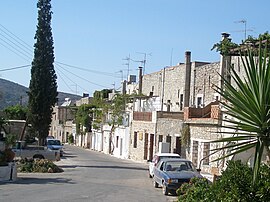Mesta, Greece
Mesta
Μεστά | |
|---|---|
Settlement | |
 The outside of the village | |
| Coordinates: 38°15′N 25°55′E / 38.250°N 25.917°E | |
| Country | Greece |
| Administrative region | North Aegean |
| Regional unit | Mastichochoria |
| Municipality | Chios |
| Elevation | 120 m (390 ft) |
| Population (2011)[1] | |
| • Rural | 337 |
| • Community | 437 |
| Time zone | UTC+2 (EET) |
| • Summer (DST) | UTC+3 (EEST) |
| Postal code | 821 00 |
| Area code(s) | 22710 |
| Vehicle registration | ΧΙ |
Mesta is a Greek traditional village on the island of Chios. It belongs to the Mastic Villages, a group of villages in South Chios where the main activity is the manufacture of mastic. The mastic villages have been added to the representative List of the Intangible Cultural Heritage of Humanity of UNESCO.[2][3] Mesta is characterised by particular architecture since it is a village-castle with perfectly preserved medieval architecture.[4][5] Mesta is located 35 km south west of Chios (town), 4 km away from the coast. It is built at a height of 120m and it belongs to Chios municipality and Mastichochoria municipal unit. It is also a community that comprises the village Limenas where the port of south west Chios is located.
History
The village was probably built in the 12th century during the Byzantine era. The architecture of the settlement with its narrow streets and perimetric fortification served to repel pirate raids. The street plan of the village is pentagonical and its many narrow roads inside the fortifications give the impression of a labyrinth. The fortifications were reinforced during the Genoese era in Chios, between 1346 and 1566. The church of the Older Taxiarchi that is located in the centre of the village was built in 1794. A lot of villagers of Mesta were killed or captured during the Chios massacre. Some of them were released after a while because the mastic agriculture was important for the Ottomans.[6]
Historical population
| Census | Settlement | Community |
|---|---|---|
| 1991 | 337 | |
| 2001 | 501 | 565 |
| 2011 | 337 | 437 |
Gallery
-
View
-
Megalos Taxiarchis belltower
-
Interior of Taxiarchis church
-
A road of the village
-
The port of Mesta (Limenas)
References
- ^ "Απογραφή Πληθυσμού - Κατοικιών 2011. ΜΟΝΙΜΟΣ Πληθυσμός" (in Greek). Hellenic Statistical Authority.
- ^ "Know-how of cultivating mastic on the island of Chios". unesco.org. Retrieved 17 February 2016.
- ^ "UNESCO recognizes the mastic cultivation of Chios". protothema.gr. Retrieved 17 February 2016.
- ^ "Μεστά". chios.com. Retrieved 17 February 2016.
- ^ "Μεστά". chiosonline.gr. Retrieved 17 February 2016.
- ^ "Ιστορία". chioshistory.gr. Archived from the original on 11 March 2016. Retrieved 17 February 2016.






